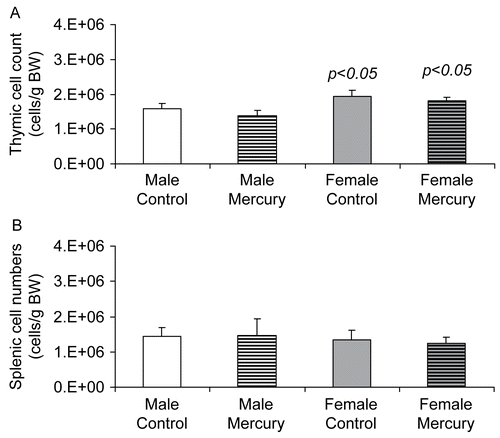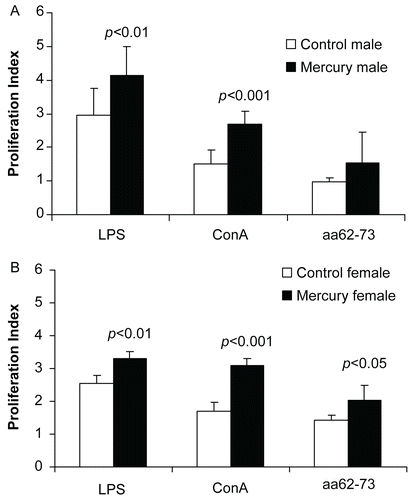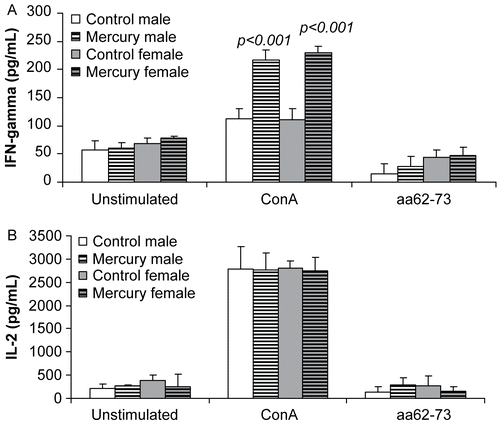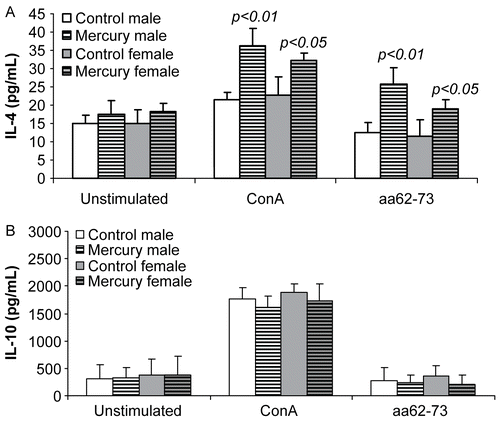Figures & data
Table 1. Litter statistics from 3 independent timed-breed experiments to evaluate the persistent immune effects of gestational exposure to 10 ppm HgCl2.
Figure 1. The effects of prenatal HgCl2 exposure on thymic and splenic cellularity. Cell numbers in the (A) thymus and (B) spleen of 10-wk-old DBF1 mice exposed to plain water (control) or 10 ppm mercuric chloride during gestation were enumerated. Data were collected from six control mice (3 female and 3 male DBF1 mice) and 12 mercury-exposed mice (6 female and 6 male DBF1 mice). The differences between mercury-exposed mice and sex-matched control mice were considered significant when p < 0.05.

Table 2. The effect of prenatal mercuric chloride exposure on CD4/CD8-expressing cells in the thymus.
Table 3. The effect of prenatal mercuric chloride exposure on CD4/25-expressing cells in the thymus.
Figure 2. Prenatal HgCl2 exposure leads to increased proliferative responses in lymphocytes. Splenic lymphocytes (5 × 105 cells) from mercury-exposed and unexposed (A) male and (B) female mice were stimulated with ConA (2 μg/ml), LPS (15 μg/ml) or idiopeptide (15 μg/ml) for 72 hr. Data were expressed as the proliferation index, computed as the ratio of the proliferative response of stimulated cells (measured as absorbance) to that of the unstimulated cells. Data were collected from 18 control mice (9 female and 9 male DBF1 mice) and 23 mercury-exposed mice (12 female and 11 male DBF1 mice) and shown as mean ± SD. The differences between mercury-exposed mice and sex-matched unexposed mice were considered significant when p < 0.05.

Figure 3. The effects of prenatal mercury exposure on the production of TH1 cytokines. In vitro production of (A) IFNγ and (B) IL-2 by lymphocytes (106 cells/well) from mercury-exposed and unexposed mice that were stimulated with ConA (2 μg/ml) or idiopeptide (15 μg/ml) was measured after 24 hr (IFNγ) or 72 hr (IL-2). Data were collected from 18 control mice (9 female and 9 male DBF1 mice) and 23 mercury-exposed mice (12 female and 11 male DBF1 mice) and shown as mean ± SD. The differences between mercury-exposed mice and sex-matched unexposed mice were considered significant when p < 0.05.

Figure 4. The effects of prenatal mercury exposure on the production of TH2 cytokines. In vitro production of (A) IL-4 and (B) IL-10 by lymphocytes (106 cells/well) from mercury-exposed and unexposed mice after stimulation with ConA (2 μg/ml) or idiopeptide (15 μg/ml) was measured after 72 hr. Data were collected from 18 control mice (9 female and 9 male DBF1 mice) and 23 mercury-exposed mice (12 female and 11 male DBF1 mice) and shown as mean ± SD. The differences between mercury- exposed mice and sex-matched unexposed mice were considered significant when p < 0.05.

Table 4. The effect of prenatal mercuric chloride exposure on IdLNF1-reactivity in splenic CD4+ T-cells.
